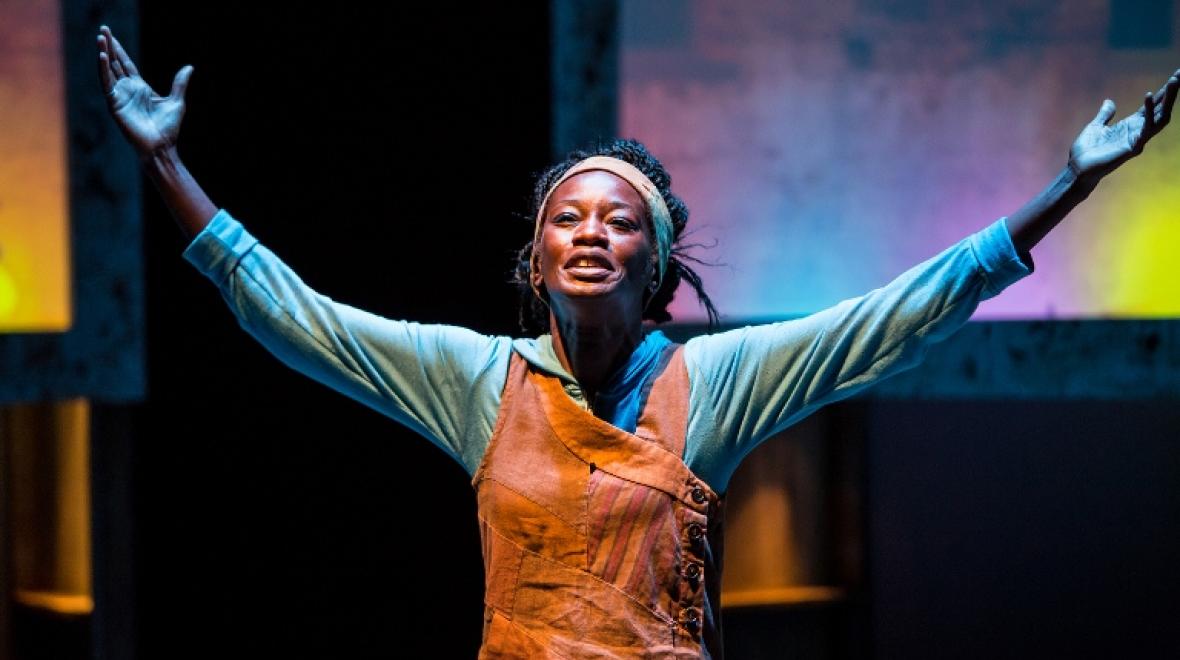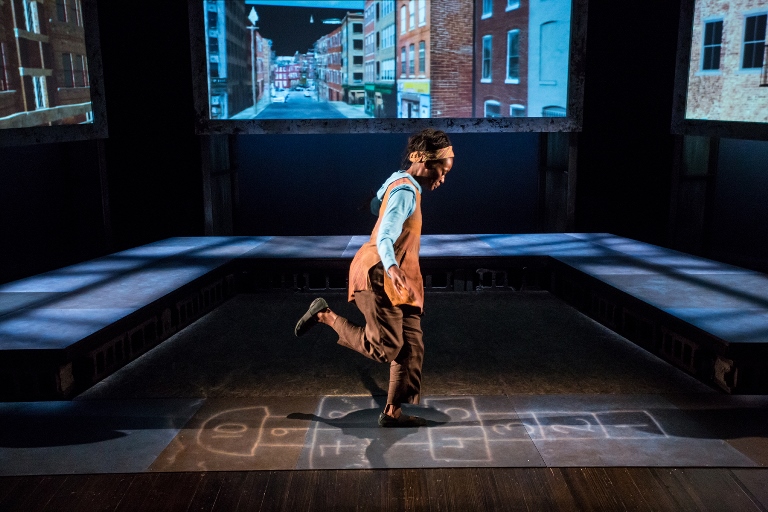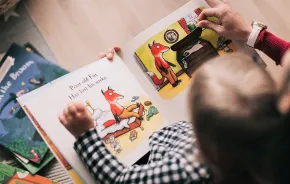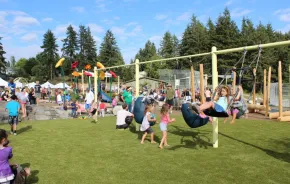
Photo:
Sonja Parks in 'Seedfolks.' Photo credit: Dan Norman
I kept a community garden plot for years, but I had doubts about Seedfolks, the Seattle Children’s Theatre production that opened last weekend about the birth of an inner-city community garden in Cleveland. How could a one-person show about a garden hold kids’ interest for over an hour when I struggle to engage my own kids in a real garden outside?
But Seedfolks, adapted from the book by Paul Fleischman, is not a one-person show. More than 20 characters make an appearance, 14 of them with significant roles. True, there is only one actor – the amazingly talented Sonja Parks, who switches among the characters so instantly and completely that even children can tell exactly who is speaking at any time.

It helps that the cast of characters is incredibly diverse, ranging from small children to elderly folks and representing a wide range of ethnicities and native languages. But it depends entirely on Parks, who performs on a nearly blank stage – a platform raised on cinderblocks surrounding a square of floor represents apartment buildings hemming in the vacant lot – with no props or costume changes. She has some technical assistance with a digital backdrop projected on three panels that moves as characters go down the block, and with recorded sound effects like creaking floors and pouring water.
The story starts with 9-year-old Kim, a Vietnamese girl who plants beans in the vacant lot on the anniversary of her father’s death. Her beans attract others to the garden, which grows as organically and imperfectly as the plants. Sometimes plants die and tomatoes are stolen. But in the end, there is community where before there was none, and the overall feeling is one of hope and beauty. And humor, because Seedfolks is very funny. An old Jewish man named Sam, a self-described peace worker, provides much of the story’s humor and its moral voice. He likes starting conversations, even among audience members. When fences start going up around plots he kvetches, “This used to be the garden of Eden, now it’s back to being Cleveland!”
There is a fine line between character and caricature, which Seedfolks walks with grace. Accents and mannerisms occasionally elicit chuckles, as do some stereotypical foibles, but Seedfolks gives each character depth and growth that go beyond stereotype. Curtis, the narcissistic bodybuilder whose braggadocio elicits out-loud laughs, starts out as a stereotypical player. He becomes real when he buys a homeless kid a sleeping bag and gives up the gym to tend tomatoes for his girlfriend.
My 8-year-old said the garden was a place where people who had sadness in their life came and helped each other.
Interestingly, some of the most profound characters are the ones whose voices are less accessible. We learn about the homeless teen Royce from others’ experiences of him; Tío Juan, the indígena Mexican man who is pulled back from depression by the garden, speaks no language known to the rest of the characters.
Now, more than ever, we need to be reminded that our commonalities are greater than what sets us apart, and we need stories that show Americans pulling together regardless of their country of origin. Seedfolks does this beautifully, full of hope and positivity without being either prim or preachy. Young widow Sae Young was robbed and beaten in her own store; janitor Wendell grieves a murdered son, but in Seedfolks hard stories are given an age-appropriate delicate touch. My 8-year-old said the garden was a place where people who had sadness in their life came and helped each other.
Parent tips
There is nothing scary or inappropriate in Seedfolks, which is recommended for ages 8 and older. Characters talk about different races with varying levels of respect but no slurs are used. One character says, “Shoot,” in a way that people are more accustomed to hear a different word, but no actual swear words are used.
Younger children may not have the context to identify the cultures represented by different characters or understand why they don’t trust each other, but the characters are sensitively developed as individual people whose stories and growth are understandable even without socioeconomic details.
Be prepared to go home inspired to garden. Consider doing so in the front yard, where you can talk to neighbors while you work. If, like the seedfolk, you don’t have a yard, contact Tilth Alliance or Seattle P-Patch to get involved in community gardening.
SCT’s downloadable audience guide is full of information about the story as well as guidance for discussing the story with kids. The Theater Etiquette page provides a helpful review of proper audience behavior (for adults and children).
If you go ...Where and when: Seattle Children's Theatre in the Seattle Center near the corner of Thomas and 2nd Ave. The show runs until April 16. The ASL interpreted performance is on April 1 at 2 p.m. Visit the SCT website for a complete production schedule. http://www.sct.org/Shows/2016-2017-Season/Seedfolks#More-Details Length: Running time is approximately 75 minutes. There is no intermission. Find your seat early and enjoy the hip-hop beats playing in the auditorium before the show. Q&A: Parks returns to the stage after the performance for a guided discussion and a Q&A with the audience. Age: Seedfolks is recommended for children 8+.Tickets: Prices vary by performance (Thursday night is cheapest), ranging from $26-$44, including fees. Parking: Visit the Seattle Center web page dedicated to transportation and parking to minimize your traffic pain. |











